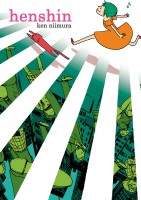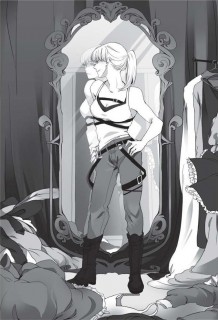 Creator: J. M. Ken Niimura
Creator: J. M. Ken Niimura
U.S. publisher: Image Comics
ISBN: 9781632152428
Released: January 2015
Original release: 2014
J. M. Ken Niimura is probably best known for his collaboration as an illustrator with writer Joe Kelly on I Kill Giants, an award-winning American comic that was completed in 2008. Among many other honors, the work earned Niimura and Kelly the top International Manga Award in 2012. A Spanish artist of Japanese descent, Niimura currently lives and works in Tokyo. Henshin is his first major Japanese publication. The collection includes thirteen short manga that were originally released online between 2013 and 2014 on the website for Ikki, a magazine that has been the home to some of my favorite mangaka, before finally being collected into a single volume. (An interesting sidenote: I Kill Giants was also published in Japan by Ikki Comix.) Henshin was subsequently released in Spanish in 2014 by Norma Editorial and in English by Image Comics in 2015. Out of the three print releases of Henshin, the English-language edition has the largest trim size.
The manga collected in Henshin are short, anywhere from twelve to twenty-eight pages in length. Although there are a variety of genres and styles, the stories generally fall into one of two broad categories: those that are semi-autobiographical, focusing on either Niimura’s creative processes or his love of cats, and those that are fictional narratives largely set in or near Tokyo or otherwise featuring Tokyoites. For the most part, the individual manga are unrelated and stand perfectly well on their own, but the first and last stories do share the same lead characters and there is a running episodic story about Niimura and a cat that lives near his apartment. Henshin includes slice-of-life manga, as well as manga with science fiction and fantasy elements, pieces infused with nostalgia, family and friends, pieces where loneliness and missed connections predominate, stories with a bit of humor, and stories with a bit of sadness.
 Although the manga in Henshin are all different, they do share some thematic and narrative similarities. The first story, “No Good,” perfectly captures the tone of the volume as a whole. It starts out as a seemingly innocent tale but it suddenly shifts into something completely unexpected and outlandish. Most of the stories in Henshin have some sort of twist to them that require the reader to reconsider and reevaluate everything that has come before. Those surprising plot developments may be humorous, touching, absurd, disconcerting, or even morbid, in any combination. In Japanese, “henshin” means transformation, metamorphosis, or change, which is exactly what the stories collected in the volume have to offer—pivotal moments in which all of a sudden things are no longer the same, demanding a new and different understanding of reality.
Although the manga in Henshin are all different, they do share some thematic and narrative similarities. The first story, “No Good,” perfectly captures the tone of the volume as a whole. It starts out as a seemingly innocent tale but it suddenly shifts into something completely unexpected and outlandish. Most of the stories in Henshin have some sort of twist to them that require the reader to reconsider and reevaluate everything that has come before. Those surprising plot developments may be humorous, touching, absurd, disconcerting, or even morbid, in any combination. In Japanese, “henshin” means transformation, metamorphosis, or change, which is exactly what the stories collected in the volume have to offer—pivotal moments in which all of a sudden things are no longer the same, demanding a new and different understanding of reality.
Niimura exhibits a range of art styles in Henshin, drawing influence from Asian, European, and American comics traditions. Some of the illustrations are simple caricatures while others are more detailed or involved, some even reminiscent of classic ink wash paintings. The artwork in each of the short manga is tailored to fit the specific story and its mood, but in every case Niimura’s illustrations show impressive narrative strength. In general, Henshin uses minimal text and dialogue—one manga is even completely wordless—relying on the artwork (which performs magnificently) to actively aid in the telling of the stories. Henshin is an excellent and rather delightful collection of charming and quirky short manga that, in all of its strangeness and occasional absurdity, remains emotionally relevant and carries an impact. I enjoyed Henshin immensely and hope to have the opportunity to read more of Niimura’s comics and manga in the future.







 SEAN: Given that
SEAN: Given that 












 MICHELLE: While I really do enjoy Say I Love You. and look forward to its sixth volume, I’ve been in a more shounen-y mood lately, and so must pick (again, and probably not for the last time) volume ten of
MICHELLE: While I really do enjoy Say I Love You. and look forward to its sixth volume, I’ve been in a more shounen-y mood lately, and so must pick (again, and probably not for the last time) volume ten of 


